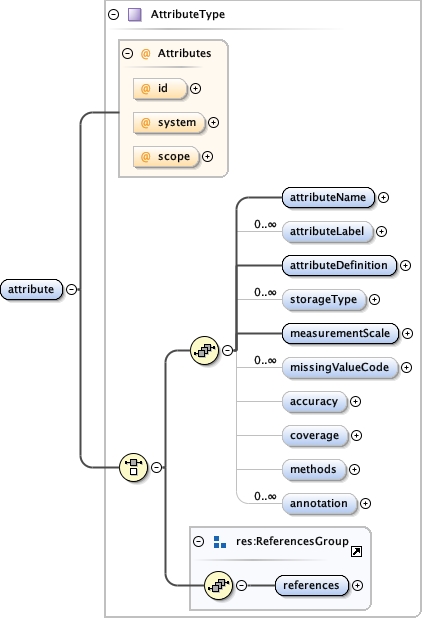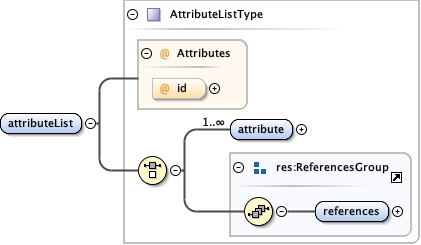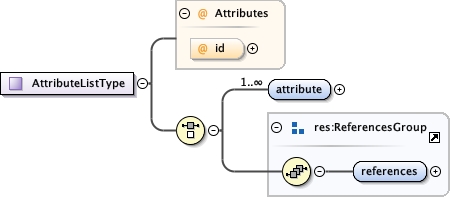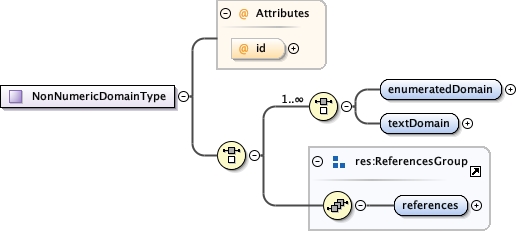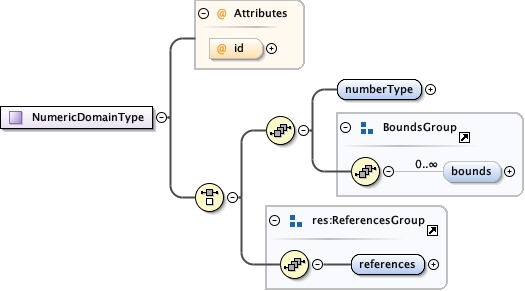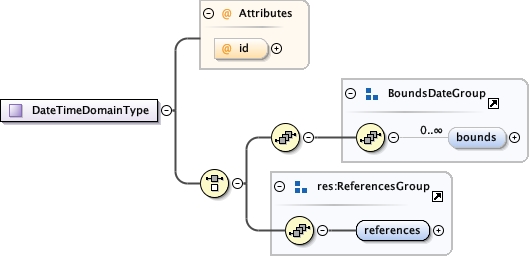<xs:complexType name="AttributeType">
<xs:annotation>
<xs:documentation>tooltip: Attribute Type summary: Type definition for the content of an attribute (variable) that can be part of an entity. description: Type definition for the content of an attribute (variable) that can be part of an entity.</xs:documentation>
</xs:annotation>
<xs:choice>
<xs:sequence>
<xs:element name="attributeName" type="res:NonEmptyStringType">
<xs:annotation>
<xs:documentation>tooltip: Attribute name summary: The name of the attribute description: Attribute name is official name of the attribute. This is usually a short, sometimes cryptic name that is used to refer to the attribute. Many systems have restrictions on the length of attribute names, and on the use of special characters like spaces in the name, so the attribute name is often not particularly useful for display (use attributeLabel for display). The attributeName is usually the name of the variable that is found in the header of a data file.</xs:documentation>
</xs:annotation>
</xs:element>
<xs:element name="attributeLabel" type="res:NonEmptyStringType" minOccurs="0" maxOccurs="unbounded">
<xs:annotation>
<xs:documentation>tooltip: Attribute label summary: A label for displaying an attribute name. description: A descriptive label that can be used to display the name of an attribute. This is often a longer, possibly multiple word name for the attribute than the attributeName. It is not constrained by system limitations on length or special characters. For example, an attribute with a name of 'spcode' might have an attributeLabel of 'Species Code'.</xs:documentation>
</xs:annotation>
</xs:element>
<xs:element name="attributeDefinition" type="res:NonEmptyStringType">
<xs:annotation>
<xs:documentation>tooltip: Attribute definition summary: Precise definition of the attribute description: This element gives a precise definition of attribute in the data entity (dataTable, spatialRaster, spatialVector, storedProcedure, view or otherEntity) being documented. It explains the contents of the attribute fully so that a data user could interpret the attribute accurately. Some additional information may also be found in the methods element as well.</xs:documentation>
</xs:annotation>
</xs:element>
<xs:element name="storageType" minOccurs="0" maxOccurs="unbounded">
<xs:annotation>
<xs:documentation>tooltip: Storage Type summary: Storage type hint for this field description: This element describes the storage type, for data in a RDBMS (or other data management system) field. As many systems do not provide for fine-grained restrictions on types, this type will often be a superset of the allowed domain defined in attributeDomain. Values for this field are by default drawn from the XML Schema Datatypes standard values, such as: integer, double, string, etc. If the XML Schema Datatypes are not used, the type system from which the values are derived should be listed in the 'typeSystem' attribute described below. This field represents a 'hint' to processing systems as to how the attribute might be represented in a system or language, but is distinct from the actual expression of the domain of the attribute. The field is repeatable so that the storageType can be indicated for multiple type systems (e.g., Oracle data types and Java data types).</xs:documentation>
</xs:annotation>
<xs:complexType>
<xs:simpleContent>
<xs:extension base="xs:string">
<xs:attribute name="typeSystem" type="xs:string" use="optional" default="http://www.w3.org/2001/XMLSchema-datatypes">
<xs:annotation>
<xs:documentation>tooltip: Storage Type System summary: The system used to define the storage types. This should be an identifier of a well known and published typing system. description: The typeSystem attribute is the system used to define the storage types. This should be an identifier of a well known and published typing system. The default and recommended system is the XML Schema data type system. For details go to http://www.w3.org. If another system is used (such as Java or C++ types), typeSystem should be changed to match the system.</xs:documentation>
</xs:annotation>
</xs:attribute>
</xs:extension>
</xs:simpleContent>
</xs:complexType>
</xs:element>
<xs:element name="measurementScale">
<xs:annotation>
<xs:documentation>tooltip: Measurement Scale summary: The measurement scale for the attribute. description: The measurementScale element indicates the type of scale from which values are drawn for the attribute. This provides information about the scale in which the data was collected.</xs:documentation>
</xs:annotation>
<xs:complexType>
<xs:choice>
<xs:element name="nominal">
<xs:annotation>
<xs:documentation>tooltip: Nominal scale summary: Characteristics used to define nominal (categorical) scale attributes description: This field is used for defining the characteristics of this variable if it is a nominal scale variable, which are variables that are categorical in nature. Nominal is used when numbers have only been assigned to a variable for the purpose of categorizing the variable. An example of a nominal scale is assigning the number 1 for male and 2 for female.</xs:documentation>
</xs:annotation>
<xs:complexType>
<xs:sequence>
<xs:element name="nonNumericDomain" type="NonNumericDomainType"/>
</xs:sequence>
</xs:complexType>
</xs:element>
<xs:element name="ordinal">
<xs:annotation>
<xs:documentation>tooltip: Ordinal scale summary: Characteristics used to define ordinal (ordered) scale attributes description: This field is used for defining the characteristics of this variable if it is an ordinal scale variable, which specify ordered values without specifying the magnitude of the difference between values. Ordinal is used when the categories have a logical or ordered relationship to each other. These types of scale allow one to distinguish the order of values, but not the magnitude of the difference between values. An example of an ordinal scale is a categorical survey where you rank a variable 1=good, 2=fair, 3=poor.</xs:documentation>
</xs:annotation>
<xs:complexType>
<xs:sequence>
<xs:element name="nonNumericDomain" type="NonNumericDomainType"/>
</xs:sequence>
</xs:complexType>
</xs:element>
<xs:element name="interval">
<xs:annotation>
<xs:documentation>tooltip: Interval scale summary: Characteristics used to define interval scale attributes description: This field is used for defining the characteristics of this variable if it is an interval scale variable, which specifies both the order and magnitude of values, but has no natural zero point. Interval is used for data which consist of equidistant points on a scale. The Celsius scale is an interval scale, since each degree is equal but there is no natural zero point (so, 20 C is not twice as hot as 10 C). zero point (so, 20 C is not twice as hot as 10 C).</xs:documentation>
</xs:annotation>
<xs:complexType>
<xs:sequence>
<xs:element name="unit" type="UnitType"/>
<xs:element name="precision" type="PrecisionType" minOccurs="0"/>
<xs:element name="numericDomain" type="NumericDomainType"/>
</xs:sequence>
</xs:complexType>
</xs:element>
<xs:element name="ratio">
<xs:annotation>
<xs:documentation>tooltip: Ratio scale summary: Characteristics used to define ratio scale attributes description: This field is used for defining the characteristics of this variable if it is a ratio scale variable, which specifies the order and magnitude of values and has a natural zero point, allowing for ratio comparisons to be valid. Ratio is used for data which consists not only of equidistant points but also has a meaningful zero point, which allows ratios to have meaning. An example of a ratio scale would be the Kelvin temperature scale (200K is half as hot as 400K), and length in meters (e.g., 10 meters is twice as long as 5 meters).</xs:documentation>
</xs:annotation>
<xs:complexType>
<xs:sequence>
<xs:element name="unit" type="UnitType"/>
<xs:element name="precision" type="PrecisionType" minOccurs="0"/>
<xs:element name="numericDomain" type="NumericDomainType"/>
</xs:sequence>
</xs:complexType>
</xs:element>
<xs:element name="dateTime">
<xs:annotation>
<xs:documentation>tooltip: Date/Time scale summary: Characteristics used to define date and time attributes description: The dateTime field is used for defining the characteristics of the attribute if it contains date and time values. DateTime is used when the values fall on the Gregorian calendar system. DateTime values are special because they have properties of interval values (most of the time it is legitimate to treat them as interval values by converting them to a duration from a fixed point) but they sometimes only behave as ordinals (because the calendar is not predetermined, for some dateTime values one can only find out the order of the points and not the magnitude of the duration between those points). Thus, the dateTime scale provides the information necessary to properly understand and parse date and time values without improperly labeling them under one of the more traditional scales. Date and time values are unlike any other measured values. Note that the dateTime field would not be used if one is recording time durations. In that case, one should use a standard unit such as seconds, nominalMinute or nominalDay, or a customUnit that defines the unit in terms of its relationship to SI second.</xs:documentation>
</xs:annotation>
<xs:complexType>
<xs:sequence>
<xs:element name="formatString" type="res:NonEmptyStringType">
<xs:annotation>
<xs:documentation>tooltip: Date/Time Format summary: A format string that describes the format for a date-time value from the Gregorian calendar. description: A format string that describes the format for a dateTime value from the Gregorian calendar. DateTime values should be expressed in a format that conforms to the ISO 8601 standard. This field allows one to specify the format string that should be used to decode the date or time value. To describe the format of an attribute containing dateTime values, construct a string representation of the format using the following symbols: Y year M month W month abbreviation (e.g., JAN) D day h hour m minute s second T time designator (demarcates date and time parts of date-time) Z UTC designator, indicating value is in UTC time . indicates a decimal fraction of a unit +/- indicates a positive or negative number, or a positive or negative time zone adjustment relative to UTC - indicates a separator between date components A/P am or pm designator Any other character in the format string is interpreted as a separator character. Here are some examples of the format strings that can be constructed. Format string Example value ------------------- ------------------ ISO Date YYYY-MM-DD 2002-10-14 ISO Datetime YYYY-MM-DDThh:mm:ss 2002-10-14T09:13:45 ISO Time hh:mm:ss 17:13:45 ISO Time hh:mm:ss.sss 09:13:45.432 ISO Time hh:mm.mm 09:13.42 Non-standard DD/MM/YYYY 14/10/2002 Non-standard MM/DD/YYYY 10/14/2002 Non-standard MM/DD/YY 10/14/02 Non-standard YYYY-MMM-DD 2002-OCT-14 Non-standard YYYYMMMDD 2002OCT14 Non-standard YYYY-MM-DD hh:mm:ss 2002-10-14 09:13:45 Some notes about these examples. First, the ISO 8601 standard is strict about the date components, their order, and the separators; e.g., date parts are upper case, and time parts are lower case. If no UTC relation information is given, the time is assumed to be in local time. Assuming local time is ambiguous even when communicating within a single time zone, given variations in Daylight Saving Time. Best practice is to follow the ISO 8601 format precisely and accurately. In particular, please note that these are all non-standard according to ISO: use of a slash (/) to separate date components, a space to separate date and time components, using a twelve-hour time with am/pm designator, placing any of the components out of descending order However, we recognize that existing data contain non-standard dates, and existing equipment (e.g., sensors) may still be producing non-standard dates. Further, data parsers often apply individual interpretations. E.g., Java interprets HH on a 24-hr clock and hh on a 12-hr clock, and MM as a padded integer for month but MMM as a 3-letter abbreviation. Consequently, the formatting string can contain characters as needed to accommodate existing data. Decimal dateTime values can be extended by indicating in the format that additional decimals can be used. Only the final unit (e.g., seconds in a time value) can use the extended digits according to the ISO 8601 standard. For example, to show indicate that seconds are represented to the nearest 1/1000 of a second, the format string would be "hh:mm:ss.sss". Note that this only indicates the number of decimals used to record the value, and not the precision of the measurement (see dateTimePrecision for that). Date and time values are from an interval scale, but it is extremely complex because of the vagaries of the calendar (e.g., leap years, and leap seconds). The duration between date and time values in the future is not even deterministic because leap seconds are based on current measurements of the earth's orbit. Consequently, date and time values are unlike any other measured values. The format string for dateTime values allows one to accurately calculate the duration in SI second units between two measured dateTime values, assuming that the conversion software has a detailed knowledge of the Gregorian calendar.</xs:documentation>
</xs:annotation>
</xs:element>
<xs:element name="dateTimePrecision" type="res:NonEmptyStringType" minOccurs="0">
<xs:annotation>
<xs:documentation>tooltip: DateTime Precision summary: An indication of the precision of a date or time value description: A quantitative indication of the precision of a date or time measurement. The precision should be interpreted in the smallest units represented by the dateTime format. For example, if a dateTime value has a format of "hh:mm:ss.sss", then "seconds" are the smallest unit and the precision should be expressed in seconds. Thus, a precision value of "0.01" would mean that measurements were precise to the nearest hundredth of a second, even though the format string might indicate that values were written down with 3 decimal places.</xs:documentation>
</xs:annotation>
</xs:element>
<xs:element name="dateTimeDomain" type="DateTimeDomainType" minOccurs="0">
<xs:annotation>
<xs:documentation>tooltip: DateTime Domain summary: See the summary for the type: DateTimeDomainType description: See the description for the type: DateTimeDomainType</xs:documentation>
</xs:annotation>
</xs:element>
</xs:sequence>
</xs:complexType>
</xs:element>
</xs:choice>
</xs:complexType>
</xs:element>
<xs:element name="missingValueCode" minOccurs="0" maxOccurs="unbounded">
<xs:annotation>
<xs:documentation>tooltip: Character for missing value summary: Character for missing value in the data of the field description: This element is to specify missing value in the data of the field. It is repeatable to allow for multiple different codes to be present in the attribute. Note that missing value codes should not be considered when determining if the observed values of an attribute all fall within the domain of the attribute (i.e., missing value codes should be parsed out of the data stream before examining the data for domain violations.</xs:documentation>
</xs:annotation>
<xs:complexType>
<xs:sequence>
<xs:element name="code" type="res:NonEmptyStringType">
<xs:annotation>
<xs:documentation>tooltip: The missing value code itself. summary: The missing value code itself. description: The code element is the missing value code itself. Each missing value code should be entered in a separate element instance. The value entered is what is placed into a data grid if the value is missing for some reason.</xs:documentation>
</xs:annotation>
</xs:element>
<xs:element name="codeExplanation" type="res:NonEmptyStringType">
<xs:annotation>
<xs:documentation>tooltip: Explanation of Missing value Code summary: An explanation of what the missing value code means. description: The codeExplanation element is an explanation of the meaning of the missing value code that was used, that is, the reason that there is a missing value. For example, an attribute might have a missing value code of '-99' to indicate that the data observation was not actually taken, and a code of '-88' to indicate that the data value was removed because of calibration errors.</xs:documentation>
</xs:annotation>
</xs:element>
</xs:sequence>
</xs:complexType>
</xs:element>
<xs:element name="accuracy" type="Accuracy" minOccurs="0">
<xs:annotation>
<xs:documentation>tooltip: The accuracy of the measured attribute summary: The accuracy of the attribute. This information should describe any accuracy information that is known about the collection of this data attribute. description: The accuracy element represents the accuracy of the attribute. This information should describe any accuracy information that is known about the collection of this data attribute. The content model of this metadata is taken directly from FGDC FGDC-STD-001-1998 section 2 with the exception of processContact, sourceCitation, and timePeriodInformation which either user XMLSchema types or use predefined EML types for these purposes.</xs:documentation>
</xs:annotation>
</xs:element>
<xs:element name="coverage" type="cov:Coverage" minOccurs="0">
<xs:annotation>
<xs:documentation>tooltip: Attribute coverage summary: An explanation of the coverage of the attribute. description: An explanation of the coverage of the attribute. This specifically indicates the spatial, temporal, and taxonomic coverage of the attribute in question when that coverage deviates from coverages expressed at a higher level (e.g., entity or dataset). Please see the eml-coverage module for complete documentation.</xs:documentation>
</xs:annotation>
</xs:element>
<xs:element name="methods" type="md:MethodsType" minOccurs="0">
<xs:annotation>
<xs:documentation>tooltip: Attribute methods summary: An explanation of the methods involved in the collection of this attribute. description: An explanation of the methods involved in the collection of this attribute. These specifically supplement or possibly override methods provided at a higher level such as entity or dataset. Please see the eml-methods module for complete documentation.</xs:documentation>
</xs:annotation>
</xs:element>
<xs:element name="annotation" type="sem:SemanticAnnotation" minOccurs="0" maxOccurs="unbounded">
<xs:annotation>
<xs:documentation>tooltip: Semantic Annotation summary: A precisely-defined semantic statement for this attribute. description: An annotation represents a precisely-defined semantic statement that applies to this attribute. This semantic statement is used to associate precise measurement semantics with the attribute, such as the property that is being measured (e.g., oboe:Characteristic), the entity that is being measured (e.g., oboe:Entity), and the measurement standard for interpreting values for this attribute (e.g., oboe:Standard). Each annotation consists of a propertyURI and valueURI that define the property and value of the statement. The subject of the statement is the eml:attribute that contains the annotation. The associated labels can be used to display the statement to users. Each URI is resolvable to a controlled vocabulary that provides a definition, relationships to other terms, and multiple labels for displaying the statement.</xs:documentation>
</xs:annotation>
</xs:element>
</xs:sequence>
<xs:group ref="res:ReferencesGroup"/>
</xs:choice>
<xs:attribute name="id" type="res:IDType" use="optional"/>
<xs:attribute name="system" type="res:SystemType" use="optional"/>
<xs:attribute name="scope" type="res:ScopeType" use="optional" default="document"/>
</xs:complexType> |
